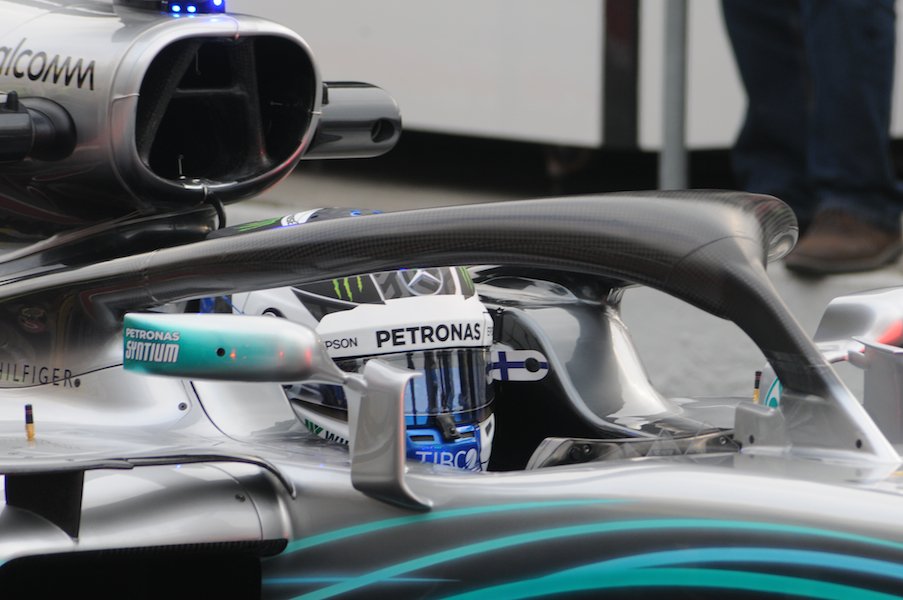Definitely see more rake there. Thanks for the post.
- Login or Register
No account yet? Sign up

Here's a photo of the car in action

It’s about concept choices. It’s not about the upper wishbone but the ability to raise the lower one. Since 2014 Mercedes ran configurations to minimize the disturbance in that area. Ferrari and others have a concept where they want less disturbances at a higher level.Tipo59/06 wrote: ↑25 Feb 2018, 03:18I'm not totally convinced that the high upper front A arms.... as they are mounted on the wheel upright..... are just for aero benefit on the 09...certainly Mercedes concept and Toro Rosso last year...ran the outer rose/ball joint quite high and outside the wheel..... right in the airstream in fact....where its not of particular benefit.....as well as a higher CG....perhaps its the high SAI or hub level offset in the front suspension geometry they are chasing here ? In that it lowers the front ride height...as the upright pivots about its axis during cornering
Ferrari and many others notably Williams and Red Bull......are on the other end of the spectrum with lower suspension and less offset ?
Any opinions ?
I guess I'm more curious as to why they run the upper rose joint(not flexure) so far in the airstream.....as they could have had the high A arms and keep them within the wheels.....the method they have chosen....is to add offset or SAI which in effect gives a ride high change(lower while turning) Is this perhaps why the FIA stepped in with a 5mm limit ?Jolle wrote: ↑25 Feb 2018, 03:30It’s about concept choices. It’s not about the upper wishbone but the ability to raise the lower one. Since 2014 Mercedes ran configurations to minimize the disturbance in that area. Ferrari and others have a concept where they want less disturbances at a higher level.Tipo59/06 wrote: ↑25 Feb 2018, 03:18I'm not totally convinced that the high upper front A arms.... as they are mounted on the wheel upright..... are just for aero benefit on the 09...certainly Mercedes concept and Toro Rosso last year...ran the outer rose/ball joint quite high and outside the wheel..... right in the airstream in fact....where its not of particular benefit.....as well as a higher CG....perhaps its the high SAI or hub level offset in the front suspension geometry they are chasing here ? In that it lowers the front ride height...as the upright pivots about its axis during cornering
Ferrari and many others notably Williams and Red Bull......are on the other end of the spectrum with lower suspension and less offset ?
Any opinions ?
You could even make a case that it’s one of the reasons Mercedes still have a fairly normal sidepod. Although the difference in hight is just a few cm, it dictates a lot of the sculpting of the barge boards and side pods. Good chance when they made that call to raise them last year (or not, in Ferrari’s case), they are stuck with them for a couple of years because of the relative big influence. You just can’t design a whole new successful car in between rule changes anymore because of all the restrictions.
Thank you for that..... The essence of that article is what I was referring to....I'm trying to wrap my brain around how the pushrod mount at the front upright can cause a ride height change at a static load...I think I'm therenevill3 wrote: ↑25 Feb 2018, 11:17A good article explaining the reasons and effect of adjusting the ride height through steering lock can be found here.
https://www.motorsport.com/f1/news/fia- ... on-990781/
He suggests the 5mm limit is too generous.
when you look at the front suspension top-down, you see that the pushrod is mounted to the upright, and is inboard a certain distance from the axis of rotation of the wheel. so as the wheel pivots, the distance from the pushrod mount on the chassis to the pushrod mount point on the uprights lengthens. as the pushrod length is static, that means that pushrod is pulling on one side and pushing on the other. if you mount the pushrod forward of the axle, that should lower one side and raise the other. i believe this is why the A-arms aren't parallel, in order to induce a tilting of the upright, and thus wheel under load.Tipo59/06 wrote: ↑25 Feb 2018, 18:52Thank you for that..... The essence of that article is what I was referring to....I'm trying to wrap my brain around how the pushrod mount at the front upright can cause a ride height change at a static load...I think I'm therenevill3 wrote: ↑25 Feb 2018, 11:17A good article explaining the reasons and effect of adjusting the ride height through steering lock can be found here.
https://www.motorsport.com/f1/news/fia- ... on-990781/
He suggests the 5mm limit is too generous.Certainly a high SAI or negative scrub radius as I was referring to achieves this in the simplest way.....my thinking was there must be a good reason why they would bring the upper ball joint out of a nice hidden spot and stick it right in the air stream....if you draw a line through the upper and lower ball joints you can see the SAI created and this will cause ride height to fall as the spindle rotates about its axis.....but also getting the A arms up as high as possible is the other part of the design concept.....Toro Rosso 17' very simular
Thank you for the article

Are those appendages on the front brake ducts new? I don’t recall seeing them at the launch.Ishwar030 wrote: ↑26 Feb 2018, 10:37Gold finish on the Front Wing Cascades
https://pbs.twimg.com/media/DW8sqNsXkAAd3X7.jpg

